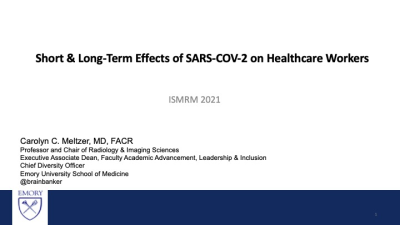Weekday Course
SARS-CoV-2: What We Know, Lessons Learned & Where We May Be Headed: Recovery, Resilience & Strategic Planning
ISMRM & SMRT Annual Meeting • 15-20 May 2021

| Concurrent 7 | 12:30 - 13:00 | Moderators: Ona Wu & Shigeki Aoki |
 |
Short- & Long-Term Effects of SARS-CoV-2 on Healthcare Workers
Carolyn Meltzer
The COVID-19 pandemic wrought unprecedented challenges for healthcare workers. Initial goals focused on the urgency of COVID-19 while delaying non-essential care, and ensuring the safety of staff, conserving PPE. As the pandemic wore on, we pivoted to caring for all patients – particularly those who deferred medical attention – in an already maximally stressed healthcare system. The blurring of work and home life, social isolation, shared grief, childcare/eldercare stresses, and superimposed racial strife has left our healthcare workforce exhausted and burned out. We must leverage lessons learned from this pandemic to reimagine healthcare systems.
|
||
| The Promise of AI for Triage & Prediction Analytics in SARS-CoV-2
Jayashree Kalpathy-Cramer
|
|||
| Post Pandemic, What Is the New Normal, What Does the Future Look Like?
Bien Soo Tan
As we ponder the new normal for Radiology post-pandemic, we should learn from past experiences. At Singapore General Hospital, we learned bitter lessons from the SARS outbreak to better prepare for the next epidemic. We need to understand the future perspectives of our patients and our workforce. Patients will expect the highest level of infection prevention practices, and a ‘just-in-time’ service, with reduced physical contact. Healthcare institutions will need to design facilities that can pivot in function during disease outbreaks. Our workforce is our most precious resource, and organizations need to understand how to better support and care for staff.
|
The International Society for Magnetic Resonance in Medicine is accredited by the Accreditation Council for Continuing Medical Education to provide continuing medical education for physicians.